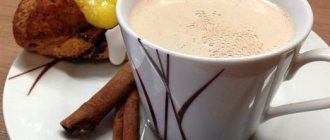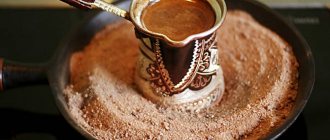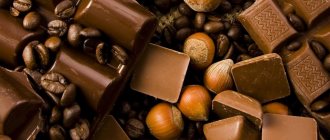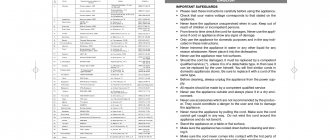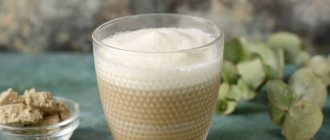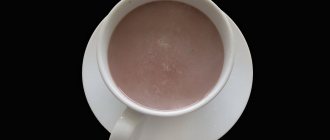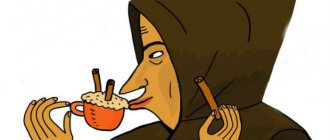The birthplace of coffee is Ethiopia, then the drink began to be prepared in Egypt and Yemen, from where it was brought to the Middle East and Europe. It is widely believed that the tradition of brewing coffee was brought to us by Peter I, a great lover of everything new. Earlier sources mention the drink, but the taste and aroma of coffee in Russia was really appreciated only in the second half of the 17th century.
The Turks were and remain true coffee connoisseurs; they developed many recipes, perfected the art of coffee brewing, and began adding spices to the drink. They also came up with the idea of preparing coffee in a special vessel - a cezve.
What is Turka
Turkish coffee is brewed in cezves - pear-shaped metal vessels with a narrow neck, thick bottom and long handle. The cezve began to be called Turkish in Russia because of its origin.
At the Sultan's court, the merits of the new drink were appreciated; coffee for the ruler was brewed in golden saucepans with a capacity of one serving. The grains were ground in front of the Sultan, and the dishes with a hot drink were immediately served to the table. Coffee was prepared over coals; if it boiled over, the aroma was spoiled. By order of the Sultan, a vessel made of tinned copper with a thick bottom was invented. Copper takes longer to heat up than gold, the narrow neck does not allow the aroma to dissipate, the cooking process is prolonged, and the drink has time to be imbued with the taste and strength of the ground grains.
Composition of mochaccino coffee
The peculiarity of mochaccino is that melted chocolate is added to espresso coffee. To simplify, some housewives add chocolate syrup, but this version of mochaccino will not have as pronounced a taste as the original.
In order to prepare a classic mochaccino, you need:
- milk;
- espresso;
- liquid chocolate;
- whipped cream.
Chocolate chips, cinnamon, caramel or nuts are used to decorate the drink.
Calorie content of mochaccino
One serving of the drink (~250 ml) contains 290 kcal.
BJU (in grams): 3|11|46.
Mochaccino price in Moscow and the region
Mochaccino in capsules: 660 rubles per package (16 capsules) or 41 rubles per serving.
The price per serving (~250 ml) of mochaccino in a cafe is 70 rubles.
Description: What is chocolate coffee (mochaccino) made from? What recipes are there for making it - with ice, in a Turkish coffee pot, in a coffee machine. Price and calorie content of mochaccino.
Which type of coffee to choose
Only two of the more than sixty varieties of coffee are of interest to coffee lovers - Arabica and Robusta.
Arabica originates from Ethiopia, but is now cultivated in different parts of the world with suitable climates. Robusta was once discovered in the Congo and spread throughout the tropics of Africa, Indonesia, Vietnam and other countries.
The Arabica variety is more popular because it has a rich taste, aroma and pleasant softness. Robusta has a sharp and bitter taste, which is liked by lovers of strong coffee. Brown Arabica beans are mixed with black robusta in various proportions and get interesting flavors, the desired strength, rich aroma and thick foam on the surface of the coffee.
Real chocolate made from cocoa butter and cocoa mass
Do you want to make a sweet that will beat store-bought chocolate? Everything is in your power! This will require a little more effort and time, and, of course, use cocoa butter and cocoa mass as the main ingredients.
You can buy them in specialized chocolatiers stores or online. By the way, on special online portals you can purchase ready-made kits for making chocolate at home. They already include all the necessary ingredients, as well as recipes for beginners.
To get real chocolate, you need to use:
- cocoa butter (50 g),
- grated cocoa (100 g),
- cinnamon and nutmeg (2 pinches each),
- sweetener (sugar, agave syrup, honey - 3 tablespoons).
The cooking process itself looks like this:
- Melt cocoa butter in a small saucepan over a water bath. Its melting point is quite low, so keep the heat to a minimum.
- Grind the cocoa liquor using a grater or a sharp knife and add to the butter when it is completely melted.
- Add nutmeg and cinnamon. Stir the mixture continuously until the cocoa dissolves.
- Add sweetener to the chocolate to taste.
- Pour the chocolate into molds, cool at room temperature and refrigerate until completely set.
This version of chocolate has a very rich taste and will definitely please those who are already disappointed in store-bought sweets. Depending on the molds you use, you can make small candies or real bars. Additions in the form of nuts, dried fruits and other goodies are welcome!
How to brew Turkish coffee: useful tips and tricks
Since the creation of Turks, many models of coffee makers and coffee machines have been created, but Turkish coffee on a regular gas or electric stove has a unique charm that Americano and espresso cannot compare with. Before brewing coffee in a Turk, you should understand some of the intricacies of the process.
The finest grind
Coffee prepared on the stove will retain its beneficial properties as much as possible if you grind the beans almost to powder. Not only the thick consistency and aroma of the drink, but also the density of the foam on the surface depends on grinding. A modern home coffee grinder is suitable for grinding; you need to grind the beans before cooking, and not for future use - when stored for a long time, ground coffee loses its aroma.
Water quantity and quality
The water must be unboiled and clean, filtered. Chilled boiled water is not suitable - this has been tested many times in practice. Pour water up to the neck of the turk, leaving room for foam.
Fire intensity
Turkish coffee at home should be brewed over very low heat. The drink should not boil violently - this will kill the taste and aroma.
Salt and sugar
Sugar, dropped into the cezve at the beginning of preparation, fully reveals the taste of the coffee, helps the foam form, but slows down the process a little. Several salt crystals perform the same task.
Cooking time
You can brew coffee in a Turk on a gas stove until the foam begins to rise. Do not let it boil, otherwise the essential oils will be destroyed.
Ground coffee portion
To prepare a standard 100-gram cup of coffee, one or two spoons of ground coffee is enough. It’s not worth adding more - the taste will not become richer, but bitterness will appear.
Foam
Making Turkish coffee at home requires the formation of foam, which prevents the aroma from evaporating. The foam will be dense if you let it rise a little several times and immediately remove it from the heat. As soon as the foam begins to settle, return the Turk to the stove. It is better not to stir the coffee while brewing so as not to disturb the barrier that preserves essential oils.
History of appearance in Russia
As for Russia, coffee gained popularity in this country at the beginning of the 19th century. The pioneer was an establishment opened in the center of Moscow called Pechkina Cafe. Famous figures of this period often gathered here, namely scientists, literary and musical figures, and various critics.
Pisemsky called it the most interesting and intellectual place in Moscow. The intellectual community welcomed this drink very cordially, inventing a new version of coffee with chocolate, the recipe for which was discussed among the intelligentsia.
Coffee with chocolate has become the hallmark of all coffee shops and restaurants. At the end of the 19th century, the import volume began to exceed 9 thousand tons, coffee took first place among drinks.
Let's look at how to make coffee with chocolate, cooking options, as well as some features associated with this drink.
How to make coffee with foam
- To make Turkish coffee at home aromatic, the beans must be ground very finely. A serving of ground coffee per 100-150 ml of water is 2 teaspoons.
- Pour coffee and sugar to taste into the cezve, you can add a pinch of salt to enhance the taste. Fill with cold water up to the neck; the smaller the area of contact between the surface of the coffee and the air, the better the aroma will be preserved.
- Place the turk on low heat. When heated, coffee particles will rise along with the water and gather at the neck into a thin crust. When the coffee starts to boil, foam will form from the crust.
- Make sure that the coffee does not boil over. Light brown foam at the neck of the Turka indicates that the water is about to boil; this cannot be allowed to happen. Remove the Turk from the heat when you see foam.
- Spices can be added when you remove the Turk from the heat for the first time or to a ready-made drink.
- Wait half a minute and return the cezve to the fire, wait for the foam to rise. If you like very strong coffee, repeat the process another time or two.
- The coffee is ready. You can add milk, cognac, lemon, etc. to it.
- You need to pour the finished coffee into a warm cup.
Frappe with chocolate chips
The Greek version of making coffee with chocolate syrup is also known throughout the world. But its preparation does not require any special skills; you can prepare it at home:
- cold espresso – 50 ml;
- crushed ice - 4 cubes;
- cream 10% - 20 ml;
- chocolate chips;
- chocolate syrup – 15 ml;
- whipped cream - balloon;
- Gingerbread Cookie.
Cooking method:
- Pour cream into cold espresso, add ice and pour into tall glasses.
- Add syrup to each serving.
- Before serving, pour balloon cream, then decorate them with a little chocolate syrup, crumbs and ginger cookies, previously ground into fine chips.
This option can be called a dessert; it is quite high in calories. But at the same time, the taste is unique; real sweet tooths will appreciate your creativity.
Coffee and cocoa – two related worlds?
In his first article “Cocoa in Torrefacto. How, why and why? I promised to talk about the parallels between cocoa and coffee. They helped spark my initial interest in cocoa—may they spark yours too!
Let me first mention one interesting difference. According to legend, the Ethiopian shepherd Kaldi discovered the properties of coffee in the 9th century AD. (1100 years ago). Cocoa was used in Central and South America long before the beginning of our era. Archaeologists have discovered traces of it in the pottery of Indians who lived in Ecuador more than 5 thousand years ago. But we will talk in detail about the history of cocoa in a separate article.
Today, coffee and cocoa are grown in the same countries, lying between the 20th parallel south and the 20th parallel north (between the Tropic of Cancer and the Tropic of Capricorn). Both crops prefer to grow in the company of other trees that provide shade for them, love a humid climate and temperatures of 15 to 30 degrees Celsius. Almost all cocoa in the world grows at an altitude of about 300 meters above sea level, about the same as robusta (Arabica likes it higher - from 800 m).
The world produces approximately twice as much coffee as cocoa, namely 10 million tons versus 4.85 million tons in 2021. It is interesting that coffee comes from Africa (Ethiopia), and the world leader in its production is Brazil. Cocoa, on the other hand, comes from South America, but is produced most of all in Africa - 70% of the volume comes from Côte d'Ivoire, Ghana, Cameroon and Nigeria.
Coffee and cocoa have a common problem - a narrow genetic base. Almost all varieties of coffee cultivated in the world are descended from Typica. The same is true for cocoa - varieties, hybrids and mutations of the Forastero group account for about 80% of global production. Why? Everything is dictated by economic considerations: the higher the yield and resistance to diseases, the more widespread this or that variety becomes. Cultivation of a narrow set of varieties poses a potential threat to the species due to the narrowness of the genetic base.
Like coffee, cocoa is primarily grown by small farmers on plantations of just a few hectares. Many are part of cooperatives that take on the function of processing the beans and selling them to exporters, and the farmer has the opportunity to quickly sell the crop and get money in hand. Needless to say, farmers get a very small percentage of the final price of chocolate made from their cocoa beans.
This situation leads to the fact that children of coffee and cocoa farmers are not eager to continue the work of their parents. The Western world is trying to support manufacturers through the Direct Trade mechanism. Its essence is as follows: chocolatiers or coffee roasters directly purchase raw materials from farmers, bypassing intermediaries. But the percentage of such products on the coffee and chocolate market still remains very small.
The modest income that cocoa farming provides is also not guaranteed. As we know, the most terrible enemy for coffee is roya (leaf rust), which can destroy the coffee industry of an entire country or region, which has happened more than once in history. Witches' broom disease and frost pod rot disease have the same destructive power, from which up to 30% of the world's cocoa crop is lost annually.
Witch's broom disease affecting cocoa trees
An analogue of the specialty class in the cocoa world is the Fino de Aroma (or Flavor Cacao) nomination. These beans account for no more than 5% of global production. A distinctive feature of this cocoa is, of course, a rich palette of tastes and aromas. Most of the cocoa in our catalog is Fino de Aroma.
Like coffee, the cocoa tree begins producing fruit a few years after planting and continues to bear fruit for 30 to 80 years. The crop is harvested twice a year: once at the end of the rainy season before the onset of droughts and again before the rainy season. The fruits on a tree do not ripen at once, so several approaches to one tree are required. The collected fruits of the cocoa trees are split open and the beans are extracted. Each fruit contains on average about 40 cocoa beans, covered with sweet pulp.
Coffee and cocoa go through similar processing steps. First, fermentation in tanks to remove sugar-containing gluten, then drying (to a moisture level of 6-7%), then rest for 1-2 months. But, unlike coffee, cocoa acquires the lion's share of its flavor and aromatic qualities during fermentation and, to a lesser extent, drying. We will definitely discuss the processing of cocoa beans in detail in a separate article - this is a voluminous topic that is important for understanding the product.
Plantation worker turns cocoa beans during fermentation
The next stage common to coffee and cocoa is roasting! Yes, cocoa beans are also roasted, both in ovens and in the same drum roasters as coffee. Of course, the approaches to roasting will be different, but there are also enough similarities. General considerations when choosing a roast profile will be bean size, moisture content, and bean flavor profile. In general, the roasting temperature for cocoa is lower than for coffee, but the roasting time is longer.
We only talked about the similarities in growing conditions and processing, but coffee and cocoa have a lot more in common. Soon I will share with you a comparison of the tastes and aromas in coffee and cocoa and, of course, we will separately talk about the last stage of processing cocoa beans - chocolate production! Subscribe to notifications about new articles on our blog to immediately know when they are published.


